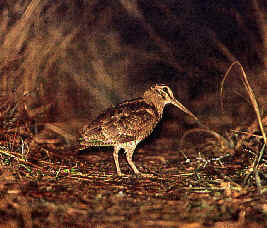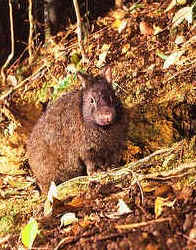
E-mail: font@focusonnature.com
Phone: Toll-free in USA 1-800-721-9986
or 302/529-1876
 |
PO Box 9021,
Wilmington, DE 19809, USA E-mail: font@focusonnature.com Phone: Toll-free in USA 1-800-721-9986 or 302/529-1876 |
THE
FOCUS ON NATURE BIRDING AND NATURE TOUR IN JAPAN
July 2009
with a Total Eclipse of the Sun

Amami Woodcock
Links:
Birds
& Other Wildlife during FONT Japan Tour - July 2009
Cumulative List of Birds during FONT Japan Tours (with some photos)
Rare Birds during FONT Tours in Japan (with some photos)
Butterflies of Japan (with some photos)
Upcoming
FONT Japan Birding & Nature Tours
Solar Eclipses & Other Celestial Nature during FONT Tours
The following was written by Armas Hill, leader of the tour:
The July 22, 2009 total solar eclipse was just one aspect of our
Japan Tour in
the Summer of '09. Yes, just one, but one that affected so many other aspects of
the trip.
As more than one Japanese person told us: "for just over 3 minutes (of
totality), it took 3 days coming and another 3 days going" in order to be
there, at the proper place and time, on Amami, with their travel only between
that small island and elsewhere in Japan.
Simply put, that's because Amami is an island, having just so many flights and
ferries to and from it, while so many Japanese people, from the main islands of
their country, were going there, and then returning home, before and after the
event.
We went to Amami by ferry from Okinawa, 4 days prior to the
eclipse. Doing so, we
had a full-day at sea, onboard a boat that went to shore at the small Japanese
islands of Yoronto, Okinoerabujima, and Tokunoshima
- all of these inhabited by
more people that one would expect, in the chain of islands either known as the
Ryukyus or Nansei Shoto.
Actually, during previous FONT tours, we traveled that ferry landing at those
islands between Okinawa and Amami. During those previous trips, we always saw
some seabirds and/or marine mammals, including various species of
dolphins, and
even, in the winter, Humpback Whale.
But, during our July '09 trip, that was not to be. A full day of scanning
produced no mammals, and not a single bird!
None of what we've seen during those
trips in the past, even as late as May, was to be seen: shearwaters of a few
species, Bulwer's Petrel, or Brown Booby.
But we did see hundreds of flying fish. And there was a Green Sea
Turtle, off
the coast of northern Okinawa.
Even though we didn't see any from the boat, terns do occur over such warm water
of the ocean. There are some species of them that are notably tropical. And even
though others, such as the Arctic Tern favor cold water, there are those that
are always where seas are warm.
One such species was especially nice to see during our time in Okinawa, before
our journey from there by ferry. We saw it from shore - a striking, mostly white
bird contrasting with the tropical blue waters that it flew above.
With a bit of
black by the eyes, and on the back of the neck, it's called the Black-naped
Tern. We saw a few of them, not only in flight over the water, but also on some
offshore rocks.
The Black-naped Tern is a bird of the tropical Pacific and Indian Oceans. It
nests on islands such as the Seychelles and Madagascar in the Indian Ocean, and
south of Japan, in the region of the Pacific in the Philippines and the Malay
Archipelago, south to northeast Australia. The southern Japanese islands of Amami
and Okinawa are at the northern limit of its range in the summer when it breeds.
Nesting, according to the book, in Japan, is between April and September. We
watched some of the terns fly out from the offshore rocks and catch fish, which
they brought back to feed to other birds, on the rocks, that looked nearly the
same. We assumed that the receivers of the fish were birds born earlier in
the summer, nearly grown.
One of our best sightings during the July 2009 FONT Japan Tour was on the
island of Okinawa, not along the coast, but inland in the forested hilly region in the
northern region known as Yambaru. It too was a bird that seemed to
be near at least one young of its brood of the year. The species is one of the
rarest of the world's birds, the Okinawa Woodpecker. In fact, if the
Ivory-billed Woodpecker (of North America) and the Imperial Woodpecker
(of
Mexico) no longer exist (and these are good assumptions), then it can
rightly be said that the Okinawa Woodpecker
is the rarest of all woodpeckers. Population estimates, over the last 2 or 3
decades, have been from 70 to 200 birds. Mostly recently, the best estimates
have been about 90 birds.
We were lucky to see an Okinawa Woodpecker as we were traveling along a road in
the hills, when it flew in front of us and landed by the side of the road on a
trunk of a tree. How's that for being handed a gift of a rare bird, figuratively
speaking, on a platter!
We parked a bit ahead, and walked back along the road, and again, as good
fortune had it, the adult woodpecker stayed in the immediate area. Apparently,
as just noted, at least one of its fledglings was still about in the woods. The
adult woodpecker frequently vocalized, communicating with another of
its kind, either the young bird or the other adult of the pair. Again, not to
belabor the point, but a bird of only 40 or so such pairs in the world! It was a
wonderful sight, that bird about 30 centimeters long, mostly brownish-black,
with some red, and a big cream-colored bill.
The Okinawa Woodpecker is also commonly called the Pryer's
Woodpecker, named
after a Mr. H. Pryer (none of my books ever give his first name). Anyway, he was
one of the Western naturalists who were in Japan in the 1870s and 1880s,
collecting specimens and cataloging birds. In 1878, he and Thomas Blakiston
(after whom the rare Blakiston's Fish Owl of Hokkaido is named) published their
"General Catalogue of the Japanese Birds" (one of the first such
writings in English).
The Okinawa, or Pryer's, Woodpecker is not closely related to any other. It's
the single member of its genus.
The look, during our July '09 tour, of the other notable avian specialty of Yambaru, the
Okinawa Rail, was but a quick glimpse as it went from a narrow country road into the
adjacent tall grass. That species only became known to science in 1982, and there's a
good reason as to why it so long escaped detection.
Earlier here it was noted that the chain of Japanese islands including Okinawa
and Amami is known as the Ryukyus. And that's the adjective for some of the
birds we encountered there: the Ryukyu Robin, the Ryukyu Minivet, and the
Ryukyu
Scops Owl.
The last of these now has another name, the Elegant Scops Owl. It is
not restricted to the Ryukyu Islands, occurring as well on other Pacific islands
known as the Celebes.
During our after-dark excursions on Amami, we heard numerous
Ryukyu, or Elegant
Scops Owls - as many as 30 or so each of two nights:
the night during which we
found the Amami Woodcock, and the next night when we quickly encountered the
rare Amami Thrush and the nocturnal Amami Rabbit. Although it's called a "rabbit", it is, like
the woodpecker on Okinawa, not like others of its kind. It's the single member
of its genus.
Another owl that we encountered in Amami was the Brown, or Oriental, Hawk
Owl.
It was seen, and heard, just after dusk.

Amami Rabbit
Earlier that day, before dusk, and after a deafening chorus of
cicadas, we saw and heard the Japanese, or Black, Woodpigeon. It's considered by Birdlife International to be a near-threatened
species, and rightly so. It's found only on a number of the smaller islands of
Japan, south of and offshore from the main Japanese islands where it does not
occur.
Two other such dark woodpigeons also occurred, historically, on the smaller
Japanese islands. But now, they are extinct.
The Bonin Woodpigeon (of the Bonin
Islands) was last seen alive in 1889, after only having been discovered in 1828.
The Ryukyu Woodpigeon (of the southern Japanese islands, of course - the Ryukyus)
was last seen in Okinawa in 1904, and last seen on the small Daito Islands in
1936. It was believed even as late as the 1960s, to still exist on small islets,
but now the species is considered extinct.
We all heard the distinctive calling of the Woodpigeon that still exists on
Amami. In the books, it's said to do "a long drawn out cow-like
mooing", while another description of its voice says that while the bird is
doing its
territorial display flights it gives "a lamb-like bleating". Thus, the
voice of a single bird has been described as sounding like two animals, a cow
and a lamb!
We also encountered, when on Amami, the Green
Pigeon. There's more than one
species of Green Pigeon in eastern Asia, so the proper adjective for the one on
Amami is the Whistling Green Pigeon. We heard it, not so much whistle, but
rather give its long, fluty mournful call, that suddenly rises and wavers.
We left from Amami on a ferry (in order to do relatively soon after the
eclipse). From that ferry, off the coast of far-southern Kyushu, a flock of
Streaked Shearwaters was seen flying by the boat.
After disembarking the ferry, in that far-southern part of Kyushu, one of the
nicest experiences of the tour was our 2-hour or so slow train-ride through
paddies, fields, forested hills, villages, and towns. Kyushu is quite
picturesque.
Elsewhere in southern Kyushu, in the summer, one of the most beautiful of all
the birds that occur in Japan resides, the eight-colored Fairy Pitta. We heard
it, but the beauty of the bird eluded us as the forest in which it lives was
also, when we were there, the home of numerous leeches. We didn't stay there long enough to see the
pitta.
Later that day, on the high Ebino Plateau in volcanic highlands, we had a picnic
- unfortunately, in the fog. At least we were out of the leech zone. We did see,
nicely, some Sika Deer, including mothers and fawns. The scientific name of the
Sika Deer is Cervus nippon.
"Nippon" is the name given by the Japanese
to their country that we call "Japan" - the country in which we had,
again, as in the past, a good and interesting tour in July 2009.
Now, in conclusion, a couple final notes:
Butterflies were plentiful during our July '09 Japan
Tour. Nearly 30 different
kinds were seen and identified. The most obvious were the large swallowtails,
but others also were notable. English names of some of the butterflies during
the tour included:
Common Mormon, Great Mormon, Red Helen, Spangle, Blue
Triangle, Great Orange Tip, Common Grass Blue, Large Tree Nymph, Common
Tiger, Indian Fritillary, Common Sailor, Diadem Butterfly, and one that occurs
many places throughout the world, the Painted Lady.
Earlier mention was made of the Black Woodpigeon being a globally
"near-threatened species" as classified by Birdlife International.
Actually, there were a few species of birds during our July '09 Japan Tour
that
are cited by that organization as endangered, threatened, or
near-threatened.
They are these:
As CRITICALLY ENDANGERED:
Okinawa, or Pryer's, Woodpecker
Amami Thrush (only about 50 birds are estimated to
exist)
As ENDANGERED:
Okinawa Rail
As VULNERABLE:
Amami Woodcock
Fairy Pitta (as noted, only heard)
Lidth's Jay
As NEAR-THREATENED:
Japanese, or Black, Woodpigeon
Whistling Green Pigeon
Elegant, or Ryukyu, Scops Owl
It was nice to cross paths with such rare creatures of the Earth, during a tour
in which we experienced a rare encounter on Earth of the Sun and the Moon in the
sky.
By the way, the next total solar eclipse in Japan
will be 26 years from now, in September
2035. And
another small Japanese island will be in the path of totality, near the center
line.
That small island is one that we at FONT know well - Hegura
Island, west
of Honshu in the Sea of Japan. We know it well because that little island has
some of the best bird migration, in the spring & fall, of anywhere that
we've been in the world.
We'd much like to go there to Hegura for the event of that upcoming eclipse at a
time when birds would be migrating south, but in 2035, I'd be 85 years
old! We'll see on that one.
However, we are scheduled to go to Hegura Island much sooner than that, for the
spring migration of birds, in May 2010.
At this time, there's still some availability on that tour.